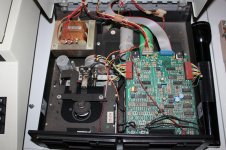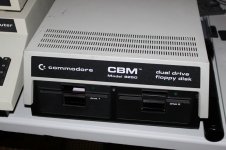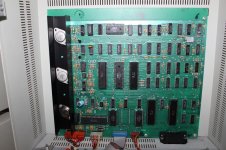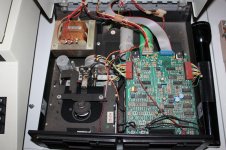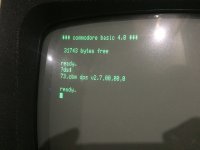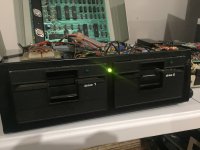Christoph
Member
- Joined
- Apr 24, 2020
- Messages
- 19
First off, hello to the group. I've been thoroughly enjoying reading through the threads here. Recently after having been absent from PETs for far too many years, I've recently secured some PETs and a few IEEE drives to play with. Thus far, I've managed to bring both of my PETs back to life, despite any real electronics knowledge. One I determined had a bad bridge rectifier and edit rom, and the other had one bad video ram chip and a defective kernal. So, I was feeling pretty good heading into the 8250 repair... but alas, I'm not sure where to start. I've never worked on one of these before, but that didn't stop me from starting in on it.
First off, I'll say that my PET I'm using for testing is functioning correctly in that the IEEE port is working fine. The 8032 I'm testing with works fine with my SFD-1001 and my MSD-SD2, so I've ruled out a problem with the PET or cable.
When I power on the 8250, both drive green lights come on, and the center light comes on red. After a moment, the left drive light goes out, the right drive light stays on and the center light flashes once, alternating between red and green. If I insert a diskette into either drive, when I close the door, the diskette spins briefly. If memory serves, that was correct behaviour for inserting a diskette.
If I try to do a catalog of the drive, the PET simply hangs. Nothing ever happens beyond that. Reading DS$ results in the same behaviour.
Now I don't know if this will help, but if I could use my functioning SFD to test chips, that would be ideal, but I don't know if that's possible. Figure it's best to check.
Looking up the "flash codes" for the 8250, I found that one flash is supposed to represent the (Zero Page 6532 UC1,UE1). So, this is now where it's becoming unclear to me, so perhaps someone could enlighten me here.
When I look up what a 6532 is, it says that it's a RIOT chip. But then, I thought the RIOT chip was the 6530? I have a little bit of experience with the RIOT in the SFD, as that one was dead for me. So I made up a daughter board based on some schematics found online, and built one of those adapter boards with an eprom on it, found the correct ROM (on the zimmers site), and got that drive going again. So, with the thought in mind that the 6532 doesn't have the EPROM portion in it, I dutifully bought what I thought would work as replacements, those being as pictured.

When I tried these, the chips got boiling BLAZING HOT almost immediately. Needless to say I powered this down immediately. I'm going to take a leap here and say those things are fried, whatever I plugged in there. I put the original chips back in, and the drive returned to it's normal non-functioning behaviour.
At this point, I thought it would be best to seek some help from anyone kind enough to pity my situation :D
So, I guess I'm looking for some perspective and advice as to what I've done, and what I've done wrong, and perhaps where I should go from here. Could I use my SFD to successfully test the 6532's from the 8250? I don't want to blow up my functioning SFD, so better to ask than leap any further. How did I go so wrong with selecting the 6532's that I bought (pictured above).
Any help or comments would be greatly appreciated.
I do have some electronics experience (mostly because I can read things on the internet). I'm trying to learn more, but learning this way is a slow process. For test equipment, I do have a scope, but have never used it (figured one day I'd get to the point where I would understand how to use it). The will is there for sure... the skill... not quite there yet.
Thanks for reading through my troubles.
Thomas
First off, I'll say that my PET I'm using for testing is functioning correctly in that the IEEE port is working fine. The 8032 I'm testing with works fine with my SFD-1001 and my MSD-SD2, so I've ruled out a problem with the PET or cable.
When I power on the 8250, both drive green lights come on, and the center light comes on red. After a moment, the left drive light goes out, the right drive light stays on and the center light flashes once, alternating between red and green. If I insert a diskette into either drive, when I close the door, the diskette spins briefly. If memory serves, that was correct behaviour for inserting a diskette.
If I try to do a catalog of the drive, the PET simply hangs. Nothing ever happens beyond that. Reading DS$ results in the same behaviour.
Now I don't know if this will help, but if I could use my functioning SFD to test chips, that would be ideal, but I don't know if that's possible. Figure it's best to check.
Looking up the "flash codes" for the 8250, I found that one flash is supposed to represent the (Zero Page 6532 UC1,UE1). So, this is now where it's becoming unclear to me, so perhaps someone could enlighten me here.
When I look up what a 6532 is, it says that it's a RIOT chip. But then, I thought the RIOT chip was the 6530? I have a little bit of experience with the RIOT in the SFD, as that one was dead for me. So I made up a daughter board based on some schematics found online, and built one of those adapter boards with an eprom on it, found the correct ROM (on the zimmers site), and got that drive going again. So, with the thought in mind that the 6532 doesn't have the EPROM portion in it, I dutifully bought what I thought would work as replacements, those being as pictured.

When I tried these, the chips got boiling BLAZING HOT almost immediately. Needless to say I powered this down immediately. I'm going to take a leap here and say those things are fried, whatever I plugged in there. I put the original chips back in, and the drive returned to it's normal non-functioning behaviour.
At this point, I thought it would be best to seek some help from anyone kind enough to pity my situation :D
So, I guess I'm looking for some perspective and advice as to what I've done, and what I've done wrong, and perhaps where I should go from here. Could I use my SFD to successfully test the 6532's from the 8250? I don't want to blow up my functioning SFD, so better to ask than leap any further. How did I go so wrong with selecting the 6532's that I bought (pictured above).
Any help or comments would be greatly appreciated.
I do have some electronics experience (mostly because I can read things on the internet). I'm trying to learn more, but learning this way is a slow process. For test equipment, I do have a scope, but have never used it (figured one day I'd get to the point where I would understand how to use it). The will is there for sure... the skill... not quite there yet.
Thanks for reading through my troubles.
Thomas

